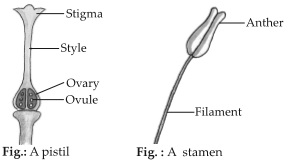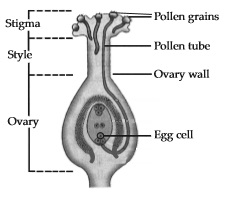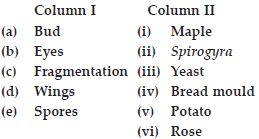Reproduction in Plants (Biology) Class 7 - NCERT Questions
Fill in the blanks :
(A) Production of new individuals from the vegetative part of parent is called _________.
(B) A flower may have either male or female reproductive parts. Such a flower is called _________.
(C) The transfer of pollen grains from the anther to the stigma of the same or of another flower of the same kind is known as _________.
(D) The fusion of male and female gametes is termed as _________.
(E) Seed dispersal takes place by means of _________, _________ and _________.
(A) vegetative propagation (B) unisexual (C) pollination (D) fertilization (E) wind, water, animals
Q 2.Describe the different methods of asexual reproduction. Give examples.
SOLUTION:Various methods of asexual reproduction are as follows :
(i) Vegetative propagation : In this method, new plants are produced from vegetative parts of the plant such as roots, stems, leaves, buds etc. It can be divided into two types :
(A) Natural vegetative propagation : This type of vegetative propagation occurs in nature through the vegetative parts. Examples : (i) Tuberous roots of Dahlia, sweet potato, Asparagus become swollen due to stored food material and can give rise to new plants. (ii) Potato plant sprouting from an eye of underground stem tuber is another example of natural vegetative propagation.
(B) Artificial vegetative propagation : It is performed manually through cutting, layering, grafting etc., e.g., formation of a complete plant from stem cutting of rose.
(ii) Budding : In yeast, a small outgrowth called bud is formed on one side of parent cell. The nucleus of the parent cell divides and one daughter nucleus migrates into the bud. The bud grows in size and eventually gets detached from the parent cell to form a new yeast cell.
(iii) Fragmentation : In this method, body of the parent breaks into distinct pieces each of which can produce new offspring e.g., Spirogyra.
(iv) Spore formation : Bacteria and fungi reproduce asexually by the formation of spores. Each spore is a tiny spherical body covered by a hard protective coat to withstand unfavourable conditions such as high temperature and low humidity. So they can survive for a long time. Under favourable conditions, a spore germinates and develops into a new individual.
Explain what you understand by sexual reproduction.
SOLUTION:Sexual reproduction is the type of reproduction, in which two parents, one male and the other female, are required. The male parent produces the male gamete or male sex cell (sperm) and the female parent produces the female gamete or egg cell (ovum). When the sperm and the egg cell fuse together, they form a third cell known as the zygote. This process of fusion of the male sex cell and the egg cell resulting in production of zygote is called fertilization.
The zygote is the first cell of the new organism. It develops into a complete organism over a period of time. In flowering plants, sexual reproduction occurs by the formation of seeds. Flowers are the main organs that take part in sexual reproduction in plants.
State the main difference between asexual and sexual reproduction.
SOLUTION:In asexual reproduction, only single parent is involved, resulting in production of offspring that are exact copies of the parent. In sexual reproduction, two parents — one male and one female are required. The offspring produced show variations as they resemble their parents in few characters but also show unique characteristics of their own.
Q 5.Sketch the reproductive parts of a flower.
SOLUTION:The reproductive parts of a flower include pistil (female reproductive part) and stamen (male reproductive part). Following are the labelled diagrams of a pistil and a stamen.

Explain the difference between self-pollination and cross-pollination.
SOLUTION:When pollen grains from the anther of a flower are carried to the stigma of the same flower or on the other flower of the same plant, it is called self-pollination.
When the pollen grains from the anther of a flower of one plant are carried to the stigma of the flower of another plant of the same kind, it is called cross-pollination.
How does the process of fertilization take place in flowers?
SOLUTION:When pollen lands on stigma, it germinates and gives rise to a pollen tube that passes through style, reaches the ovary of the pistil and enters the ovule. The pollen tube releases two male gametes one of which fuses with the female gamete (or egg) and forms a zygote. This process of fusion of a male and a female gamete to form a zygote is called fertilization. The zygote divides several times in order to form embryo.
The process of fertilization is shown in the given figure.

Describe the various ways by which fruits and seeds are dispersed.
SOLUTION:Fruit and seed dispersal occurs in the following ways :
(i) Dispersal by wind : The seeds and fruits that are dispersed by wind are usually small in size and light weight. They possess wings or hair like structures to help them float in air e.g. winged seeds of drumstick, hairy seeds of cotton etc.
(ii) Dispersal by water : Some aquatic plants and the plants that grow near water possess seeds
240 | reproduction in plants Class 7 | Biology
that can float over water and are therefore, carried away by water to far off places e.g., coconut has a thick fibrous coat that helps it to float on water.
(iii) Dispersal by animals and humans : Birds, animals and humans help in the seed dispersal in many ways. Some fruits and seeds are spiny or hooked, which get attached to the bodies of animals or humans and are carried to distant places, e.g., Xanthium, Urena, etc. Edible part of certain fleshy fruits (e.g., apple) is eaten by animals, birds or humans and the seeds are thrown away.
This helps in the dispersal of seeds. The small and undigested seeds of some fruits (e.g., guava, tomato etc.) pass out unaffected from the digestive tract of animals and are dispersed away from the parent plant.
(iv) Dispersal by explosion : In some cases, seeds are dispersed by bursting of fruits with sudden jerks. The seeds get scattered far from the parent plant, e.g., pea, balsam, castor etc.
Match items in Column I with those in Column II:

(A) - (iii), (B) - (v), (C) - (ii), (D) - (i) (E) - (iv)
Q 10.Tick  the correct answer :
the correct answer :
(A) The reproductive part of a plant is the
(i) leaf (ii) stem (iii) root (iv) flower.
(B) The process of fusion of the male and the female gametes is called
(i) fertilization (ii) pollination (iii) reproduction (iv) seed formation
(C) Mature ovary forms the
(i) seed (ii) stamen (iii) pistil (iv) fruit
(D) A spore producing organism is
(i) rose (ii) bread mould (iii) potato (iv) ginger.
(E) Bryophyllum can reproduce by its
(i) stem (ii) leaves (iii) roots (iv) flower.




